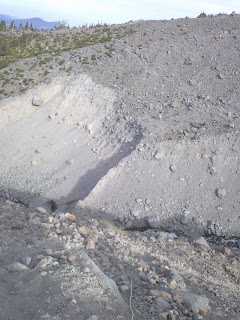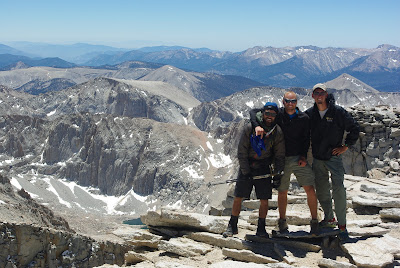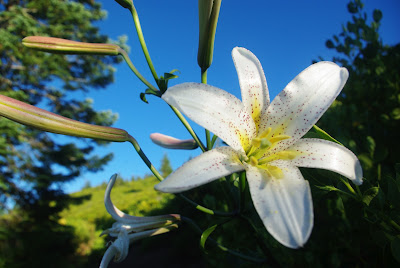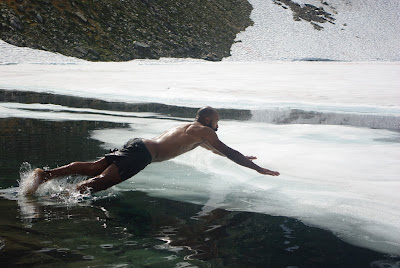The Timberline trail is a 40.3 mile loop that circumnavigates Mt. Hood. Built in the 1930's by the Civilian Conservation Corps (thank you CCC for building many-a-trail!), its lowest point hits 3,240ft when crosing the Sandy River and it's highest point hits 7,300ft on Mt. Hood's NE side near the old Cooper Spur climbing route. I found the trail to be a fun challenge with amazing views and varying landscapes. It encompasses all a Cascade volcano has to offer including huge glacial carved canyons, swift glacial streams, a variety of foliage (including the abundant Lupine), large burnt areas, soft/sandy trail, volcanic rock, and endless elevation gain. I chose to hike the route clockwise, quickly re-walking the section of trail I had already experienced when hiking the PCT in August, leaving the remainder of the trail as uncharted territory (in my respects). Note: The PCT and the Timberline trail connect for about 11 miles from Timberline Lodge-West. The average backpacker will take about 3-4 days to complete the loop. Earlier this summer, a friend of mine who is an active Ultra-Marathon runner completed the loop in just over 9.5 hours. I decided to walk at my thru-hiking pace and completed the trail in about 15 hiking hours, spread across 3 days.
 |
| Mt. Hood's SW aspect near Paradise Park |
 |
| Sun still above the smoky clouds looking SW |
After a while I reached the North side of Mt. Hood and stopped to eat lunch in the middle of a burned area. There was a beautiful little rock shelter off the side of the trail surrounded by black charred trees and black soil. The next several miles were of similar characteristics. Thousands of burned trees, new plant life, smaller canyon crossings and ever changing views of Mt. Hood and the surrounding wilderness. On the mountain, larger glaciers were in view with gnarly looking crevasses. The sound of Pika's chirping in the distance (from the rocks that they live in) was the only wildlife I really encountered. Also, water was abundant on this side of the mountain (almost too abundant) calling for tactical moves when crossing glacial drainage. The trickiest part of the trail would be crossing the washed out Elliot Drainage. In 2006 a large section of trail was destroyed during a storm where today's switchbacks lead to vertical drop-offs making it impossible to cross. Officially this section of trail is closed and hikers are expected to shuttle by car to the other side of the drainage, but shuttling wasn't an option for me and I knew of no detour. When researching about the crossing, people had mentioned of alternate routes (with fixed rope) that bypassed the damaged section of trail. Upon arrival to the situation, I contemplated climbing down the original steep embankment, but decided to find the alternate route that involved less exposure and loose rock. After climbing up the canyon's ridge for about 1/4 mile, I found cairns that led to another steep slope, this time supported by an old weathered rope that lead towards the bottom of the canyon. I chose this route (instead of hiking on and traversing the glacier above the canyon) and easily made my way down to the Elliot Drainage, crossed the stream, and climbed out of the canyon on the opposite side (again supported by another weathered rope) to where the trail continued.
 |
| Coming around Bald Mountain looking back |
From here on it was a non-stop climb to the trails highest point of Lamberson Spur. On my way up I passed many day hikers who visited the beautiful, but receding Elliot Glacier from the Cooper Spur climbers route. Looking at the Mountains north-northwest aspect, there lay an amazing view of glaciers, snow fields, and vertical crags. I could only imagine what it would be like to summit Mt. Hood via the technical Cooper Spur route, a route with 50+ degree slopes, widely popular in the 1950s and 60s. All the while, the day was coming to an end and as I approached Lamberson Butte after about 10 hours of walking, I decided to make camp on its ridge next to a monster view of the Newton Clark Glacier, its glacial runoff, craggy cliff faces, Central Oregon's high desert, and the hues of the setting sun. I was satisfied for having hiked 25 miles and over 6,000ft of elevation gain, hungry, and ready to sleep. The temperature was significantly cooler that night which resulted in a better night sleep.
 |
| Mt. Hood's NE aspect |
After waking up this morning, I quickly packed up and headed down and around Lamberson Butte. On my way down I crossed paths with a friend who went to the same college as me, a past PCT hiker, and long-distance runner. He wore no gear but a small chest strap with storage compartments and held a water bottle in each hand. He was running the Timberline Trail in the opposite direction as I, and was expected to complete his run in 10-12 hours. After a brief conversation we went our separate ways and I continued with my slow backpacking pace clockwise into the non-wilderness/ski resort lands of Mt. Hood Meadows and Timberline. Before I reached Meadows, I had to cross a couple of pretty large but entertaining canyons with glacial drainages. Upon reaching the ski lifts, I passed by 3 different hunting parties and recall my father mentioning that it's opening weekend for deer hunting in Oregon. I thought it quite dumb to be packing rifles in the middle of a ski resort, on the Timberline Trail with other hikers, and on such a small section of allowable hunting land (national forest). From then on I kept on high alert for any gun toting, slow moving, slightly obese people walking towards me :)
 |
| Looking North towards Mt. Adams above smoke |
 |
| One of the many canyons the trail crosses (at lower elevation) |
It wasn't long after crossing Mt. Hood Meadows ski resort that I neared Timberline Resort. After all, from the Meadows side of White River Canyon, you can see a large section of Timberline's Palmer ski lift. The last fun obstacle before the sandy ascent to Timberline lodge was crossing the White River drainage. It reminded me of crossing the (coincidentally named) White River canyon near Cabazon, CA when hiking the PCT, but a lot smaller. Mt. Hood's White River drainage was at the bottom of the large canyon that separated the two resorts and consisted of a large flat rocky riverbed that was marked with cairns. Before entering the drainage, a sign read something like "Caution: Dangerous glacial run-off ahead" which got me excited. Shortly after finding my way across, the Timberline Trail once again joined the PCT and continued up the canyon's sandy ridge to the resort where my car was waiting.
Hiking the Timberline Trail was a quick but rewarding experience. I enjoyed the pleasures of hiking solo but would have also enjoyed sharing the experience with others. I also got the chance to view the Mt. Hood during an interesting time of year and witness the affects that climate change has portrayed on its alpine environment. At the very least it got me off my ass from two weeks of post PCT delirium.











































